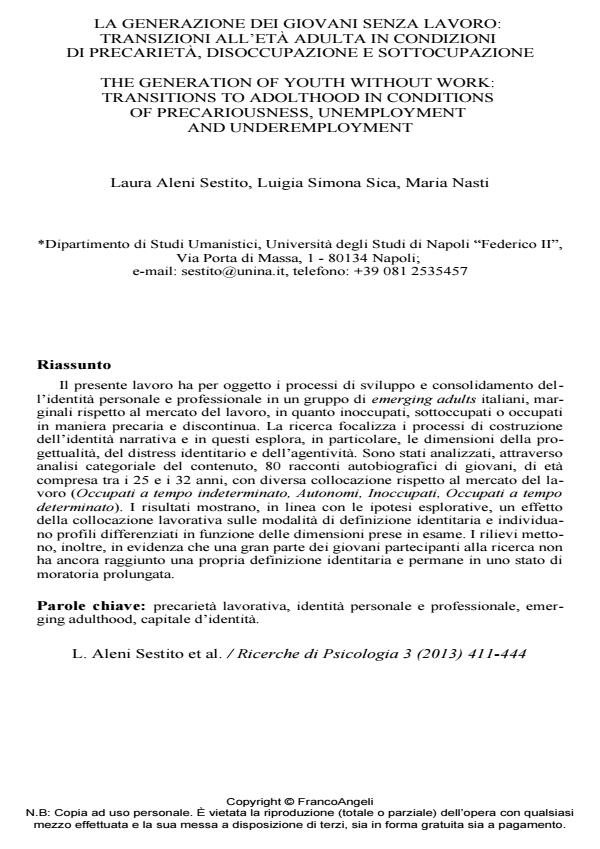The generation of youth without work: transitions to adolthood in conditions of precariousness, unemployment and underemployment
Journal title RICERCHE DI PSICOLOGIA
Author/s Sestito Laura Aleni, Luigia Simona Sica, Maria Nasti
Publishing Year 2014 Issue 2013/3
Language Italian Pages 33 P. 411-443 File size 1853 KB
DOI 10.3280/RIP2013-003002
DOI is like a bar code for intellectual property: to have more infomation
click here
Below, you can see the article first page
If you want to buy this article in PDF format, you can do it, following the instructions to buy download credits

FrancoAngeli is member of Publishers International Linking Association, Inc (PILA), a not-for-profit association which run the CrossRef service enabling links to and from online scholarly content.
The study focuses on the consolidation processes of both personal and professional identity, in a group of Italian emerging adults, marginal referring to the labour market for job insecurity, unemployment and underemployment. The study focuses on narrative identity, in particular on future orientation, identity distress and identity capital. 80 autobiographical stories of young people on different placement of the labour market (Full-time, Part-time, Independent Workers, Unemployed) were analysed through categorical analysis of textual content. The results show, in line with the hypothesis, an effect of the type of job placement on the identity formation, and they define profiles differentiated in function of the analysed dimensions. Furthermore, the results show that majority of participants, although emerging adults, didn’t achieved identity definition and stay in moratorium.
Keywords: Precariousness, personal and professional identity, emerging adulthood, identity capital.
- Raccontarsi ogni giorno: un intervento di orientamento universitario in itinere ispirato all'expressive writing e alla narrative vocational identity Luigia S. Sica, Laura Aleni Sestito, in RICERCHE DI PSICOLOGIA 4/2015 pp.607
DOI: 10.3280/RIP2014-004005 - Tra distress e agentività: il difficile percorso di consolidamento identitario nelle narrazioni di giovani adulti inoccupati o precari Simona Luigia Sica, Sestito Laura Aleni, in PSICOLOGIA DELLA SALUTE 1/2016 pp.111
DOI: 10.3280/PDS2016-001010 - Career development told through narrative research: exploring the stories of Italian and English young people Tiziana Di Palma, Hazel Reid, in International Journal for Educational and Vocational Guidance /2019 pp.129
DOI: 10.1007/s10775-018-9372-7
Sestito Laura Aleni, Luigia Simona Sica, Maria Nasti, La generazione dei giovani senza lavoro: transizioni all’età adulta in condizioni di precarietà, disoccupazione e sottocupazione in "RICERCHE DI PSICOLOGIA " 3/2013, pp 411-443, DOI: 10.3280/RIP2013-003002